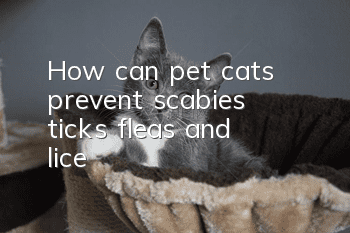How can pet cats prevent scabies, ticks, fleas, and lice?

Cat scabies, ticks, fleas and lice are relatively common diseases that occur on the body surface and can cause abnormal hair loss, itching and other symptoms in cats. The cause of the disease cannot be ruled out as low resistance. Many times, several diseases will occur together, which means that the symptoms we see are not only caused by one disease. Therefore, when a cat develops a disease, the owner must take the cat to the hospital for a smear test to determine which type it is. disease.
1. Scabies
1. Pathogen and transmission: Scabies is a contagious disease caused by scabies. Scabies has 4 pairs of legs, including ear scabies that parasitizes in the ear canal, and spider scrub typhus on the skin ( Dander typhus), autumn typhus, etc. This disease is transmitted through contact, so direct contact with sick cats or sharing grooming utensils can cause infection.
2. Symptoms: This disease mainly occurs on the nose, eye frames, ears and other heads, or on the chest, abdomen, armpits, inner thighs and tail base. The skin of the affected area will be flushed, thickened, scaly scabs, and ears. The edge of the contour is thickened, hairless due to itching, and the skin has eczema-like lesions. If infected with ear scabies, there will be a large amount of brown-black earwax, and the sick cat will have symptoms such as shaking its head and scratching its ears, and may even cause otitis externa. Sometimes people who come into contact with sick cats can become infected and develop an itchy erythematous rash.
3. Treatment: First clean the affected area with warm soapy water to remove scabs and dirt; wash the affected area with 5% formaldehyde solution, twice a week until cured; use 2% trichlorfon solution to treat the affected area Cats take a full-body medicated bath once a week. Because cats have the habit of licking their fur, the concentration of the solution should not be too high; 0.1 mL of insect killer should be injected subcutaneously. In order to kill the larvae and eggs under the epidermis, another injection was performed after 7 days. Due to bacterial infection in the affected area of the sick cat, penicillin was injected intramuscularly once a day for 5 days. Two weeks later, the sick cat began to grow hair at the hair loss site.
4. Prevention: Pay attention to the care and management of cats on daily basis to enhance their own resistance. Keep the breeding environment, the cat itself, and all utensils clean at all times, clean earwax regularly, and pay attention to scabies infection; if you find hair loss, thickened auricles, or scaly scabs, see a veterinarian immediately for diagnosis and treatment.
2. Tick
1. Pathogen and transmission: Ticks are not common on cats. They are usually brought back by cats when they go to the countryside or play in trees, and the number of infections is mostly in single digits. Female ticks will significantly increase in size after feeding on blood, but male ticks will not.
2. Symptoms: Severe infection will cause anemia, and the bitten site will be red, swollen, and inflamed; some ticks will secrete toxins when sucking blood, damaging the nervous system and causing paralysis. This is the so-called tick poisoning. Additionally, ticks can transmit Lyme disease to humans, cats, and cats.
3. Prevention and treatment: If walls are found on your cat,For ticks, you can put alcohol or flea or lice extract on the tick, wait a few minutes, and then use tweezers to remove it with its mouthparts. If the mouthparts are not pulled out, it may become infected and cause abscesses. In addition, there are some sprays, drops, and lotions on the market that can kill ticks, but cats are more sensitive to certain drugs. It is best to ask you for advice. Detailed treatment methods from veterinarians are more appropriate.
3. Flea
1. Pathogen and transmission: Fleas are small, brown-black blood-sucking insects with three pairs of legs. They have excellent jumping ability. Cat fleas are common on cats. After sucking blood, female fleas lay eggs and drop them on the ground or cat nests. After they hatch in the environment and undergo larvae, pupae, and adults, they then jump to a suitable host to parasitize.
2. Symptoms: Cats will be extremely itchy after being bitten by fleas. This is caused by the stimulation of toxins contained in the saliva of fleas; severe cases can cause allergic dermatitis; clinically, small scabs can be seen scattered on the waist and shoulders. , tail hair loss and skin turning red; and strong itching will make the cat restless.
3. Treatment: wear a collar. You can wear a flea collar for your cat, which is simple and convenient. Collars are divided into domestic and imported ones. The domestic ones are cheap, about 10 yuan each, but they have a strong smell and the slow-release effect is not very good. Some cats don’t like them, and because they are “strong”, they can easily cause poisoning. Kittens Cannot be worn. In comparison, the imported ones are much more refined, have little taste, and have a good sustained-release effect. They are much more expensive in terms of price, about 70-80 yuan each. Kittens can also be brought, but they need to be left to dry for a day (to disperse the smell). bath. Take a medicated bath with bug-repelling shampoo or specialized bug-repelling liquid. Bathing with special medicine is also a way to get rid of fleas. After washing, almost all fleas that can be seen on the cat will be killed. However, the effect of this method can only last for a short period of time. It can only kill the adult fleas on the cat and has little effect on the flea eggs. It should be noted that cats that are too young and have not been vaccinated are best not to take a bath to get rid of fleas. It is recommended to use safer methods to prevent accidents.
4. Prevention: In addition to parasitizing cats, cat fleas can also suck human blood; they are also the intermediate host of tapeworms, so it is very important to maintain a clean environment. Although there are many flea sprays, drops, dips, powders, flea collars, etc. on the market, you should still seek professional advice from your veterinarian and use their guidance to choose the most appropriate treatment method.
4. Lice
1. Pathogen and transmission: Lice are very host-specific. White cat lice will parasitize cats for life, feeding on their hair and dander, and the gray-white, translucent lice eggs they produce are also Will stick to the coat; generally speaking, cat lice infections are less common than lice infections.
2. Symptoms: Infection with cat lice can cause itching and dandruff.The hair is rough and tangled, causing the cat to scratch, bite, and rub the affected area.
3. Treatment: The validity period of sprays and powders is very short. If lice grow in the environment around the cat, the cat will soon develop lice again. Cat collars also have a certain validity period and need to be replaced in time. Some people say that the range of cat collars for killing lice is limited, and lice may grow in places other than the cat’s neck. The quality of cat collars purchased domestically varies, so be careful when choosing. According to experience, it is not recommended to use domestic collars, especially for young cats. It should not be used if there is more than one cat in the house to avoid cats licking each other. There have been many cases of cats suffering from anorexia, diarrhea and other poisoning symptoms due to licking the collar
Bathing agents can only wash away and kill adult worms on cats, but are ineffective against eggs. The mechanism of insecticide is: drop the medicine on the cat's skin, and the medicine will quickly penetrate into the skin and produce slight toxicity. The lice will be poisoned when they bite the cat again. Because the effect of the drug lasts for a long time (about a month), if new lice hatch, they will be poisoned quickly during the validity period of the drug. According to the experience of domestic pet owners, these two drugs have the best effect in killing lice. However, it should be noted that there are strict restrictions on the dosage of Methionin. It cannot exceed the dosage specified in the instructions, otherwise it may cause skin allergies. It cannot be used on kittens under three months old and pregnant female cats. Fulin is expensive, but the product is safe and suitable for kittens and pregnant cats.
4. Prevention and treatment: When combing or bathing cats, you should pay attention to whether there are traces of lice eggs or lice, and regularly disinfect and clean the environment. Sick cats must be consulted by a veterinarian. If the infection is too severe, the cat may need to be shaved for treatment.
Cat scabies, ticks, fleas and lice have a high recurrence rate. Even if they are cured, you must pay attention to the cleanliness of the environment and the cat’s nutrition. After all, if the cat gets sick again, the treatment effect will not be good.
- How to train a kitten to be angry?
- Can cats eat grapefruit?
- Why do Turkish Van cats need to be neutered?
- Why are Siamese cats getting darker and darker?
- What should I do if the corners of my cat’s mouth are broken?
- Kitten suddenly gasps like asthma
- How to choose cat litter for cats?
- What to do if the end of a kitten’s tail is bent
- What should I do if my cat has severe hair loss?
- What to do if a British shorthair cat has diarrhea



